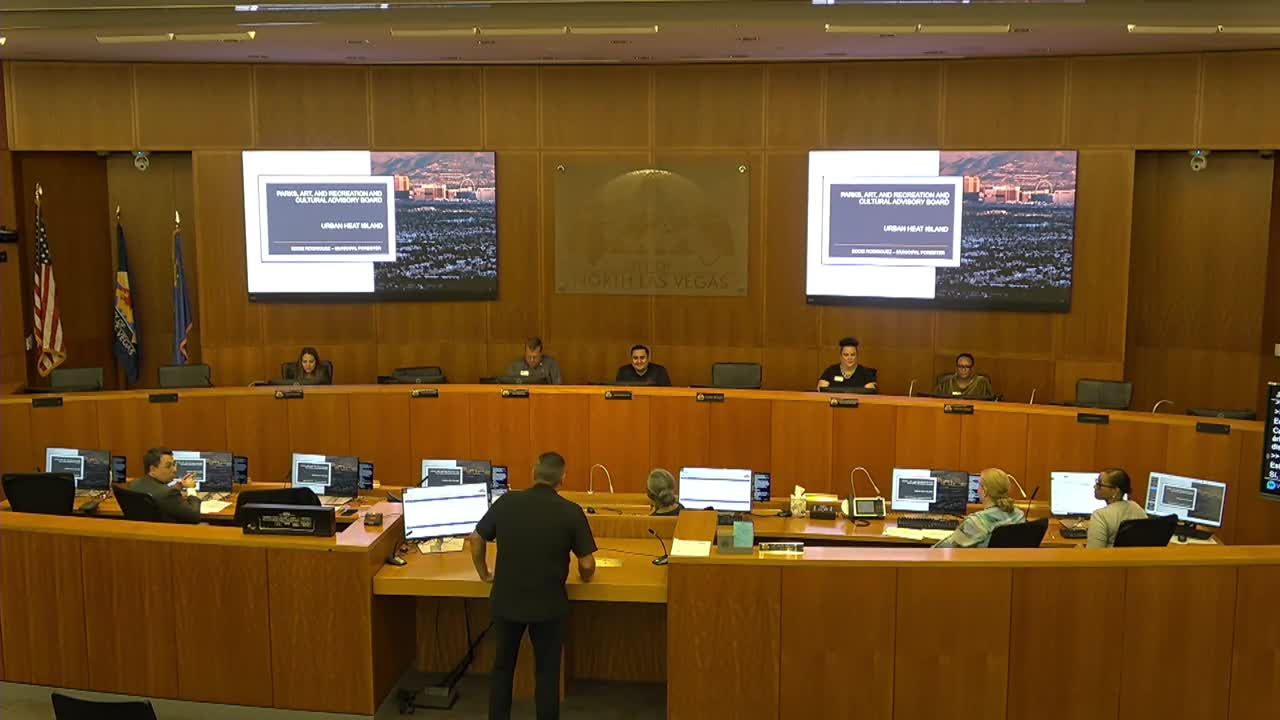North Las Vegas forester: rising heat is exceeding trees' tolerance; city shifts to heat‑tolerant plantings
October 21, 2025 | North Las Vegas, Clark County, Nevada
This article was created by AI summarizing key points discussed. AI makes mistakes, so for full details and context, please refer to the video of the full meeting. Please report any errors so we can fix them. Report an error »

Eddie Rodriguez, municipal forester for the City of North Las Vegas, told the Parks, Arts, Recreation and Culture Advisory Board on Oct. 14 that rising daytime and nighttime temperatures are stressing and killing many common trees in the Las Vegas Valley and explained the city’s new strategy to improve urban tree survival.
Rodriguez said a study covering 1970–2022 found average temperatures in the Las Vegas Valley have increased about 6 degrees Fahrenheit, making it among the fastest‑warming U.S. cities, and that climate projections show average increases of 7–9 degrees by midcentury. “We are starting to see trees and plants fail throughout the valley,” Rodriguez said, citing a Southern Nevada Water Authority‑related analysis that predicted many commonly planted species will exceed their heat tolerance by 2025.
Rodriguez said the city has shifted away from the older “drought tolerant” framework toward explicitly choosing heat‑tolerant species and described five main approaches staff are using: species selection, water management, soil management (including a 4‑inch mulch layer), planting groupings and revised maintenance practices. He listed species the city is planting — several oak varieties, eucalyptus, Chinese pistache, sissoo and acacia — and said the city has planted 1,520 trees since the current program began about 18 months ago, with a goal of planting 5,000 by 2032.
On water, Rodriguez said deeper, less frequent watering helps roots resist heat stress by keeping stomata functioning and improving the tree’s thermal resistance. For soil, he said mulch preserves soil moisture, cools the root zone and reduces direct solar heating of the soil surface. On plantings, he told the board the city prefers clusters of three to seven trees rather than solitary specimens so plants can shade and support each other.
Rodriguez also said over‑pruning immediately before high temperatures contributed to recent, rapid tree die‑offs and that city contract specifications now limit removals to about 5–15% of foliage at a time to preserve canopy density. “Over thinning raises the leaf temperature,” he said, adding that indiscriminate pruning can convert a 15‑year canopy into a stump that will take years to replace.
Board members praised the outreach and asked how the city is sharing the approach with homeowners, HOAs and contractors. Rodriguez said he is speaking widely — at the Southern Nevada Water Authority, industry conferences and media interviews — and that the city will post resources on its municipal forestry web pages and develop a recommended tree list.
City staff also said North Las Vegas recently received a national Legacy Project Award from the Urban and Community Forestry Society for the Kyle Ranch Orchard project, and that the city is being recognized regionally for its forestry efforts.
Ending: Rodriguez offered to provide the full presentation to board members and said the city will continue outreach to residents, utility partners and local arborists while pursuing planting and canopy preservation goals.
Rodriguez said a study covering 1970–2022 found average temperatures in the Las Vegas Valley have increased about 6 degrees Fahrenheit, making it among the fastest‑warming U.S. cities, and that climate projections show average increases of 7–9 degrees by midcentury. “We are starting to see trees and plants fail throughout the valley,” Rodriguez said, citing a Southern Nevada Water Authority‑related analysis that predicted many commonly planted species will exceed their heat tolerance by 2025.
Rodriguez said the city has shifted away from the older “drought tolerant” framework toward explicitly choosing heat‑tolerant species and described five main approaches staff are using: species selection, water management, soil management (including a 4‑inch mulch layer), planting groupings and revised maintenance practices. He listed species the city is planting — several oak varieties, eucalyptus, Chinese pistache, sissoo and acacia — and said the city has planted 1,520 trees since the current program began about 18 months ago, with a goal of planting 5,000 by 2032.
On water, Rodriguez said deeper, less frequent watering helps roots resist heat stress by keeping stomata functioning and improving the tree’s thermal resistance. For soil, he said mulch preserves soil moisture, cools the root zone and reduces direct solar heating of the soil surface. On plantings, he told the board the city prefers clusters of three to seven trees rather than solitary specimens so plants can shade and support each other.
Rodriguez also said over‑pruning immediately before high temperatures contributed to recent, rapid tree die‑offs and that city contract specifications now limit removals to about 5–15% of foliage at a time to preserve canopy density. “Over thinning raises the leaf temperature,” he said, adding that indiscriminate pruning can convert a 15‑year canopy into a stump that will take years to replace.
Board members praised the outreach and asked how the city is sharing the approach with homeowners, HOAs and contractors. Rodriguez said he is speaking widely — at the Southern Nevada Water Authority, industry conferences and media interviews — and that the city will post resources on its municipal forestry web pages and develop a recommended tree list.
City staff also said North Las Vegas recently received a national Legacy Project Award from the Urban and Community Forestry Society for the Kyle Ranch Orchard project, and that the city is being recognized regionally for its forestry efforts.
Ending: Rodriguez offered to provide the full presentation to board members and said the city will continue outreach to residents, utility partners and local arborists while pursuing planting and canopy preservation goals.
View full meeting
This article is based on a recent meeting—watch the full video and explore the complete transcript for deeper insights into the discussion.
View full meeting